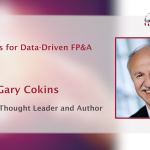In this short video Ron Monteiro, Corporate Director of Finance at Kruger Products L.P., outlines a...
 Data storytelling is a growing trend that is picking pace with each passing day. From multinationals to small startups, presenting the data as a story is a way that is proven effective and engaging. Skip the complex Excel sheets or memorising too many figures when you can communicate them more simply. Here are some key pointers for finance professionals working internally for a company. Let’s have a look.
Data storytelling is a growing trend that is picking pace with each passing day. From multinationals to small startups, presenting the data as a story is a way that is proven effective and engaging. Skip the complex Excel sheets or memorising too many figures when you can communicate them more simply. Here are some key pointers for finance professionals working internally for a company. Let’s have a look.
What is Data Storytelling?
Data storytelling is a way of communicating the results and outcomes from data analysis more efficiently and comprehensively. It is the representation of data in a combined visual and textual way to demonstrate the purpose of data and what insights it is giving to the business or audience in general.
Why Present Data in Story Form?
Coming to the genesis point of the data story, why the need to present data in a story form? Well, the key reasons are:
Data is complicated
Data is just numbers and figures, which are hard to understand, and not everyone can read it or identify the trends and changes in it. In a story form, it is clearly stated what the last figure was, what current ones are, what caused the difference and what is triggering it.
More engagement
Huge spreadsheets, numerical charts, or numbers will bore the audience, and it won’t connect them with you. Thus, the sole purpose of presenting or analysing the data won’t be communicated to them, and no effective outcome will come from it.
Data in a story form engages multiple brain sections and drives attention, emotion, and memory all at once so that the audience will listen, relate and process your data in their brains.
Faster solutions
With a simpler presentation, the information is absorbed easily, and the audience or executives can suggest, make faster decisions, and find solutions.
Primary Skills You Need to Become a Data Storyteller
To become a data storyteller, you must be focused on the following three skills:
Data analysis
Without understanding data and being able to analyse and price it, you can’t tell it in a story form. So, the first skill required is data analysis - the ability to read and manipulate data.
Storytelling
You got to know how to do magic with words if you want to become a data storyteller. Engaging words, continuous flow, and keeping the interest in the story all the time are key to a good story.
Knowledge about the business or industry
Another vital factor is business understanding or industry insights, so you know what kind of data affects the company and how to fix the issue.
Key Factors in a Data Story
Not every story is worth reading or gives good results. The core features to make your data story effective are:
Data
Data and that too good. Use relevant data, focused and filtered, to generate the graphs and story.
Visuals
Use infographics, charts, clips, or trends arc to present the data points.
Narrative and context
Why is the analysis done, what is the reason, and what are the results? Build the whole story around a straightforward narrative, and the context should be easy to pick for the audience.
Quick Tips to Become an Outstanding Data Storyteller
- Pick the right data, and filter out the irrelevant and repeated data points to have less but quality data.
- Define the origin or key reason for data collection. What was the need for research, and what were the driving factors?
- State your narrative clearly. Devise a draft map or sketch of the story and then build the whole data story around those points.
- Join the transitional points, and explain what factors led to the collected results and the reasons behind those changes.
- Using visual representations such as graphs and infographics is an easier way to represent a huge chunk of data in simple forms giving the audience a clear idea of what you are saying with fewer numbers.
- Consider the audience while forming the story. The wording, level of charts, or design of the story must match the understanding level of the audience.
- Predict outcomes and suggest solutions that can fix the changes or unhealthy trends in data.
- Use a user-friendly design. The easier points or story sections you present, the more audience it will attract and impact.
Summing It Up
Data storytelling is the future of the data world, which has increased data utilisation to attain better outcomes and communicate the driving factors to decision-makers.
It’s the need of time, and businesses are opting for data storytelling strategies to maximise their growth. But if it is not done right, it will cause havoc, so to become a brilliant storyteller, focus on what you want to communicate and how creatively you can transfer your thoughts and insights to the audience through your data story.
Happy data storytelling!
Subscribe to
FP&A Trends Digest

We will regularly update you on the latest trends and developments in FP&A. Take the opportunity to have articles written by finance thought leaders delivered directly to your inbox; watch compelling webinars; connect with like-minded professionals; and become a part of our global community.






